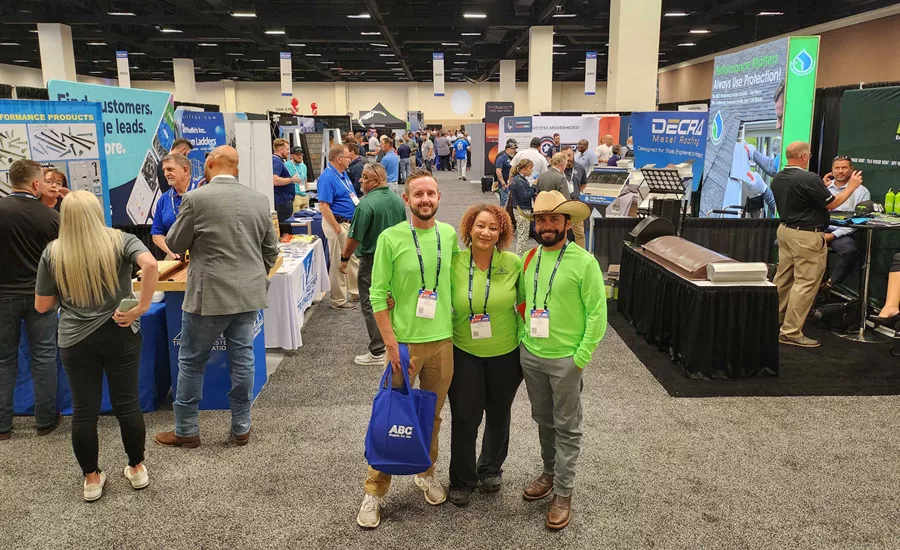Workforce Development
Take the Time to Train
Training Elevates Your Company and Helps the Industry You Serve

Taking the time to invest and participate in training (whether industry-specific or general knowledge) for you and your team pays dividends beyond just for your roofing company; it can also benefit the industry and the homeowner.
Robby Wilkerson, co-owner of the Bryan, Texas-based firm Sustainable Roofing, is fostering a work culture where a thirst for training is part of the corporate culture and shared the many benefits in our podcast interview.
“The value of training is limitless, and it comes in so many different forms,” Wilkerson says. “From employee retention to gaining the trust of our clients while we’re working onsite, to having a team with a wide spectrum of similar skills [allowing] for consistent results no matter who is assigned the project.
“For example, I’ve had team members who were not as well versed on attic ventilation as I am,” Wilkerson adds. “They were tripped up while on the project and had to reach out to me for assistance to explain to the homeowner why we wanted to correct the attic ventilation, but if you have the entire team trained on all the same knowledge, it guarantees the same results and a seamless sales process.”

Sustainable Roofing Owner Robby Wilkerson and Production Manager Kris Delgado at a lunch-and-learn with an Attic Breeze representative in Bryan, Texas.
Training Helps Spread Knowledge Equally
Wilkerson says every person on his team can fill in at any point for any other person because of the ongoing commitment to training across the board.
“That’s anything from the initial sales call to the behind-the-scenes ordering of materials, to scheduling crews, conducting an attic ventilation inspection, overall project management, and we can all do it," Wilkerson says. “This comes in handy if someone is unavailable for whatever reason — vacation, family emergency, already out on another project, whatever. We just call on the next person to step in and don’t miss a beat.
“We don’t have to hold anything up. Any one of us can step in and make it happen.”
Among the training topics the principal is particularly interested in is attic ventilation.
“Attic ventilation is one of the cornerstones of why we wanted to start our own roofing company,” he says. “Being a roofer in Texas, I thought I knew about proper attic ventilation, but honestly, I had not even heard the term ‘net free area’ (the total unobstructed area through which air can pass through a vent) until I left Texas and moved to Oregon. It was there while I continued my roofing career in the Pacific Northwest, I attended [Air Vent's] seminar, and my eyes were opened.
“In Portland, it’s cold and wet for five months out of the year, and mold can become a huge issue. We don’t have that problem in Texas. It’s just hot. But in Portland, when I went on attic ventilation inspections, I could physically see dead spots in the attic ventilation where mold would start to grow.
“I was then able to form a visual in my mind how attic ventilation works — from intake to exhaust one seamless airflow circuit in and out — and I wanted to bring that back with me when we returned to Texas,” Wilkerson says. “We wanted to help homeowners lower their attic temperatures, save on their utilities, and help make their roofs last longer. Doing this helps us gain the homeowner's trust as roofing professionals because we’re not just simply installing a roof.”

Sustainable Roofing owners Robby and Jaycee Wilkerson with Malarkey representatives at a recent Roofing Contractors Association of Texas Conference in San Antonio. Photos courtesy of Sustainable Roofing.
Training Helps Boost Sales
Wilkerson says there’s also a financial gain by expanding your knowledge base.
“Because we are well versed in attic ventilation … we can pivot our sales teams in the exceptionally hot months of July and August when roofing projects slow a bit in Central Texas; shift[ing] some of our focus to improving attic ventilation,” he says, adding, ‘[it] help[s] boost our sales because we can advertise and promote that part of the roofing project.”
Whether it’s best practices in attic ventilation, tips for flashing chimneys, or the latest roof covering materials, Wilkerson wants his team to know.
“Our motto is ‘A Better Approach to Roofing,’ and so we always want to be trained in the latest in roofing and attic technology and applications,” he says. “We always want to be on the forefront of that to best help our customers.”
How often does Sustainable Roofing pursue training?
“Every single day is a potential training opportunity,” Wilkerson acknowledges. “I have been in roofing eight years and have owned a roofing company, along with my wife Jaycee, going on three years now — it’s amazing how many tidbits of knowledge you learn and gain during that time.”
So every time I’m out on a project with someone and we’re up on a roof, I like to share,” Wilkerson says. "Each roof is different and has unique aspects to it. I like to point those out when I can. Training doesn’t have to be a formal event or seminar. It can be learning on the job. That’s how I view every roofing project every day. I deeply desire to share knowledge and help others succeed with that knowledge.”
Training Helps Energize Employees
A possibly underappreciated value of offering training to your team is its motivational impact on employees.
“We brought our production manager to [Air Vent’s] seminar in Houston,” Wilkerson says. “He made it a point to say ‘thank you’ after the seminar [and] appreciated being included.”
Wilkerson added that his production manager noted how his previous employer treated him as a “grunt worker.” He never invested the time or money to formally train him in roofing besides on-the-job training. The production manager said he appreciated feeling like part of a team and knowing that Wilkerson was investing time and money into ensuring his employee was up-to-date on best practices, adding that the production manager believes the investment will allow him to serve customers better.
Wilkerson has a few tips for fellow company owners to get team members excited about training opportunities.
“You can turn it into an event where you participate in the training, but you also attend a sporting event or some other activity the day before or after, perhaps,” he says. “Take them out for a special dinner before or after the training; make it almost a ‘company outing,’ and if you’re regularly sharing and learning together throughout the year, you’ll create a ‘thirst for gaining knowledge.’”
Wilkerson added that the added-value proposition is how everyone on the team will start to feel more professional in their industry and become receptive to even more training opportunities.
If work projects prohibit everyone from attending a training event, Wilkerson says it ensures those who missed out attend the following year.
“We want everyone on our team to have the same level of training across the board. It benefits them and Sustainable Roofing,” he says. “Eventually, what happens is your team leans on you — as the owner — less and less, and they become more self-sufficient as a result of a commitment to training.
“You receive fewer of those ‘Hey, what do I do here’ phone calls because everyone is elevating their knowledge base,” Wilkerson says. “[T]hat frees you, as owner, to focus on other areas of the business that need your attention, including growing the business.”
Looking for a reprint of this article?
From high-res PDFs to custom plaques, order your copy today!







